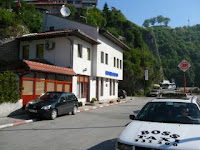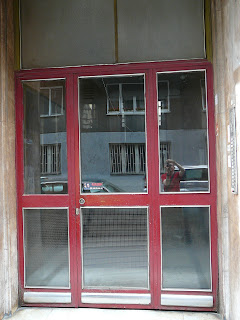




 I have been asked to post pictures of
I have been asked to post pictures of [Version française:
On m’a demandé d’ajouter des photos de l’Ouest du Montana, en plus de celles prises autour de Havre. C’est fait. Ces photos ont été prises au cours d’un voyage fait en Aôut 2006 à
On this blog, I'll mostly post pictures taken during my travels. Occasionally, I will post notes on one of my passions: books. Sur ce blog, il y a surtout des photos prises au cours de mes voyages. A l'occasion, j'y parlerai aussi d'une de mes passions: les livres.





 I have been asked to post pictures of
I have been asked to post pictures of  On les trouve un peu partout en Bosnie-Herzégovine. Des petits modèles surtout, que l’on n’a plu vu plus en
On les trouve un peu partout en Bosnie-Herzégovine. Des petits modèles surtout, que l’on n’a plu vu plus en 

“louchki most”) à Mostar. D’autres ont vu des jours meilleurs et parfois même ont changé de function, comme celle-ci, l’orange, garée tout contre un mur de maison et remplie de cartons. Celle-ci, c’est presque sur, on ne la verra plus sur les routes.

[English version:

in Mostar. Others have clearly seen better days and some of those even have a different function now, like the orange one parked near a house wall and filled with cardboard. This one, for sure, will not be seen on the road.
PS: Looking at my pictures of Belgrade once more, I see that I have unintentionally photographed yet another Renault 4 while I was there. This green beauty is shown on the right.

 Yes, I know, these posts should be chronological but aren't. This is because I just started this blog, and I am still catching up. It will get a bit more sensical soon, promised... These pictures were taken during our first trip to Montana (V. and I) in August 2006. They were taken in and around Havre, MT, where we have family. Montana is called the "big sky state," for obvious reasons.
Yes, I know, these posts should be chronological but aren't. This is because I just started this blog, and I am still catching up. It will get a bit more sensical soon, promised... These pictures were taken during our first trip to Montana (V. and I) in August 2006. They were taken in and around Havre, MT, where we have family. Montana is called the "big sky state," for obvious reasons. Pour les français qui ont un peu de mal avec l’anglais, ces photos datent de l’été dernier, au mois d’Aôut 2006, quand V. et moi sommes allés en vacances dans le




 It's friday afternoon in Sarajevio, Bosnia. I arrived last night at 11pm on the bus from Belgrade, and today, after a day at the Sarajevo office of our partner company, I am out exploring the town. After changing to shorts and a t-shirt at the hotel (hotel Emona in Bembasa), I cross one of the bridges which go over the miljacka river and find myself in the middle of nature. The air is incredibly fragrant with what I think is wisteria (I am later told that is not wisteria but "locust tree" (or "acacia" in french), whose flowers are edible). Then I notice music coming from a stereo nearby: soulful bosnian folk music of the kind V. and I sometimes listen to in New York. I walk towards where it is coming from and happen upon the recording of
It's friday afternoon in Sarajevio, Bosnia. I arrived last night at 11pm on the bus from Belgrade, and today, after a day at the Sarajevo office of our partner company, I am out exploring the town. After changing to shorts and a t-shirt at the hotel (hotel Emona in Bembasa), I cross one of the bridges which go over the miljacka river and find myself in the middle of nature. The air is incredibly fragrant with what I think is wisteria (I am later told that is not wisteria but "locust tree" (or "acacia" in french), whose flowers are edible). Then I notice music coming from a stereo nearby: soulful bosnian folk music of the kind V. and I sometimes listen to in New York. I walk towards where it is coming from and happen upon the recording of  a video. The young film crew is on the right and I can barely see a singer on the left, surrounded by greenery. This is a moment of pure balkan magic. I get closer, turn on the zoom on my digital camera and take the next picture, a close-up of the singer. She is holding her glasses in her left hand and a flowering branch in her right. My bosnian is not very good but I understand some of the word: "... moje bela sarajavo grada..." ("my beautiful city of Sarajevo..."). I stay until the end of the song and move on, filled with a feeling of pure joy.
a video. The young film crew is on the right and I can barely see a singer on the left, surrounded by greenery. This is a moment of pure balkan magic. I get closer, turn on the zoom on my digital camera and take the next picture, a close-up of the singer. She is holding her glasses in her left hand and a flowering branch in her right. My bosnian is not very good but I understand some of the word: "... moje bela sarajavo grada..." ("my beautiful city of Sarajevo..."). I stay until the end of the song and move on, filled with a feeling of pure joy.


 One of the many cemeteries dotting the hills of Sarajevo. The siege of Sarajevo by the Yougoslav People's Army (JNA), aided by bosnian serb forces lasted three years, from April 5th, 1992 to February 29th, 1996. This was the longest siege in the history of modern warfare.
One of the many cemeteries dotting the hills of Sarajevo. The siege of Sarajevo by the Yougoslav People's Army (JNA), aided by bosnian serb forces lasted three years, from April 5th, 1992 to February 29th, 1996. This was the longest siege in the history of modern warfare.







 This post is an homage to the resilient, courageous, friendly, fun, strong, beautiful people of Belgrade. I hope that the worst times for this city belong to the past. I will come back to visit soon.
This post is an homage to the resilient, courageous, friendly, fun, strong, beautiful people of Belgrade. I hope that the worst times for this city belong to the past. I will come back to visit soon.
 These two pictures were taken in Kalemegdan, the "Central Park of Belgrade." It is where you go when you feel like breathing clean air or when you feel romantic (it's a major make-out spot), or when you just want to take a walk away from traffic. Located at the confluence of the Sava and Danube rivers, Kalemegdan displays layer upon layer of architectural history. You'll find there: a roman well, fountains from ottoman times, ancient portals and fortifications. It's a pretty amazing place.
These two pictures were taken in Kalemegdan, the "Central Park of Belgrade." It is where you go when you feel like breathing clean air or when you feel romantic (it's a major make-out spot), or when you just want to take a walk away from traffic. Located at the confluence of the Sava and Danube rivers, Kalemegdan displays layer upon layer of architectural history. You'll find there: a roman well, fountains from ottoman times, ancient portals and fortifications. It's a pretty amazing place. Sveti Marko Crkva (St Marko's church) is my favorite church in Belgrade. It is an orthodox church located near Tasmajdan Park. I learned recently that it was destroyed in 1941 by german bombs and that it was subsequently rebuilt. Tasmajdan seems to have a fascinating history of its own since under the park can be found a network of secret passages used during communist times.
Sveti Marko Crkva (St Marko's church) is my favorite church in Belgrade. It is an orthodox church located near Tasmajdan Park. I learned recently that it was destroyed in 1941 by german bombs and that it was subsequently rebuilt. Tasmajdan seems to have a fascinating history of its own since under the park can be found a network of secret passages used during communist times. One of my favorite spots in Belgrade: Kalenic pijaca (Kalenic market), the largest open air green market in the city. In this place you can find all sorts of fruit, flowers, vegetables. In may, there were flower sellers with big bunches of peonies and lots of people selling strawberries.
One of my favorite spots in Belgrade: Kalenic pijaca (Kalenic market), the largest open air green market in the city. In this place you can find all sorts of fruit, flowers, vegetables. In may, there were flower sellers with big bunches of peonies and lots of people selling strawberries. The colorful trams of Belgrade. This picture was taken not far from Kalemegdan. Studenski Trg is on the right.
The colorful trams of Belgrade. This picture was taken not far from Kalemegdan. Studenski Trg is on the right. A funky Art deco building. I love the clock at the top.
A funky Art deco building. I love the clock at the top. One of the many remnants from communist times in downtown Belgrade. Although you'll have a hard times finding a native of Belgrade agreeing with you on this, it seems to me that under the right kind of light these "ugly buildings" have a certain grace and beauty of their own.
One of the many remnants from communist times in downtown Belgrade. Although you'll have a hard times finding a native of Belgrade agreeing with you on this, it seems to me that under the right kind of light these "ugly buildings" have a certain grace and beauty of their own. The staircase of the apartment building where I stayed in Belgrade. I got to know it well, because although the apartment was on the sixth floor I had a deep mistrust of the rickety elevator, which I had nicknamed the "socialist elevator" (get in, close the wood doors, light goes off, press random button to a floor, get to floor, light goes off again, etc.). These stairways are so bright that some tenants put house plants there.
The staircase of the apartment building where I stayed in Belgrade. I got to know it well, because although the apartment was on the sixth floor I had a deep mistrust of the rickety elevator, which I had nicknamed the "socialist elevator" (get in, close the wood doors, light goes off, press random button to a floor, get to floor, light goes off again, etc.). These stairways are so bright that some tenants put house plants there.
 One last walk in Kalemegdan before I was to catch my plane back to New York later that day. The Danube is on the right.
One last walk in Kalemegdan before I was to catch my plane back to New York later that day. The Danube is on the right.












 Chaque ville d’une certaine taille semble avoir sa charactéristique propre. Lors d’un voyage à
Chaque ville d’une certaine taille semble avoir sa charactéristique propre. Lors d’un voyage à